In the days of bark canoes repairs were made during a trip with emergency materials carried for just such a purpose, namely pitch. If need be a replacement canoe would be constructed from the natural materials harvested in the field. But what do canoe trippers carry and use nowadays? Have you ever needed to make repairs on a canoe during a trip? Do you have a repair kit, and what's in it?
-
Happy Premiere of Tchaikovsky's "The Nutcracker" (1892)! 🩰🥥🧚
You are using an out of date browser. It may not display this or other websites correctly.
You should upgrade or use an alternative browser.
You should upgrade or use an alternative browser.
In The Field Canoe Repair
- Thread starter Odyssey
- Start date
I carry one and have used it quite often! I carry a west system epoxy repair kit http://www.westsystem.com/ss/repair-kits A roll of gorilla tape, some 12" cable ties, a short 6" piece of 1/8" threaded rod with nuts and washers, some tie wire, shoe goo, and some light (1mm) cord.
with these items I can (and have) replace a broken seat riser bolt, stitch up a split in the hull, fill a puncture, patch a large hole, splint or reattach a thwart, or even patch together a folded boat enough to get home
with these items I can (and have) replace a broken seat riser bolt, stitch up a split in the hull, fill a puncture, patch a large hole, splint or reattach a thwart, or even patch together a folded boat enough to get home
- Joined
- Nov 19, 2013
- Messages
- 1,521
- Reaction score
- 1,243
In all the years of doing canoe trips I've been pretty lucky. The only true repair I had to make was to a 17' Grumman which leaked all along the keel. At lunch on the first day we flipped it over to let it dry in the sun. Just before heading off again I duct taped the entire keel,bow to stern, and it never leaked again over the rest of the trip; which was 6 days.
Other than that, nothing. I just hope I haven't jinxed myself now
That's all for now. Take care and until next time...be well.
snapper
Other than that, nothing. I just hope I haven't jinxed myself now
That's all for now. Take care and until next time...be well.
snapper
I used to carry an epoxy repair kit, but after years of never using it, I just rely on good old duct tape. Gorilla tape is pretty good. Usually carry a few bolts and nuts and some wire too.
On my longer trips I carry a little cloth, (fiberglass and carbon) peel ply, and resin. Some of the carbon is sleeving in case of a broken thwart or paddle shaft. Also small mixing cups, sandpaper, chip brushes and nitrile gloves. I carry an alcohol stove so use that fuel for prep and cleanup. The cloth, peel ply, and chip brushes went in a zip-lock bag. The resin and hardener (in syringes for easy measurement) went into a 48oz. Nalgene bottle to eliminate the possibility of accidental discharge.
I used some fiberglass to repair the worn through stems on my last trip. It went quite well but I realized that if I had needed to make a much larger repair (or another later on) that I probably didn't have enough resin.
 20150905_010 by Alan, on Flickr
20150905_010 by Alan, on Flickr
 20150905_001 by Alan, on Flickr
20150905_001 by Alan, on Flickr
 20150905_008 by Alan, on Flickr
20150905_008 by Alan, on Flickr
 20150906_001 by Alan, on Flickr
20150906_001 by Alan, on Flickr
If I was doing a mostly lake trip or a short 7-10 day trip I probably wouldn't bring such an elaborate repair kit. But I didn't like the thought of something breaking on day 5 of a 30+ day river trip and having to cobble it together.
Alan
I used some fiberglass to repair the worn through stems on my last trip. It went quite well but I realized that if I had needed to make a much larger repair (or another later on) that I probably didn't have enough resin.
 20150905_010 by Alan, on Flickr
20150905_010 by Alan, on Flickr 20150905_001 by Alan, on Flickr
20150905_001 by Alan, on Flickr 20150905_008 by Alan, on Flickr
20150905_008 by Alan, on Flickr 20150906_001 by Alan, on Flickr
20150906_001 by Alan, on FlickrIf I was doing a mostly lake trip or a short 7-10 day trip I probably wouldn't bring such an elaborate repair kit. But I didn't like the thought of something breaking on day 5 of a 30+ day river trip and having to cobble it together.
Alan

Fixed with duct tape.. paddled another 50 miles out. In Temagami. I would henceforth go with a little more than duct tape. Wrap in a small waterfall. I was very lucky
- Joined
- Mar 20, 2013
- Messages
- 3,356
- Reaction score
- 972
Duct tape, snare wire... That is it... You can "sew" a ripped boat in half and you will be able to put it back together with these and it will last the rest of the trip no problem... 8 days after a kevlar canoe was wrapped on a rock, recovered with lots of long cracks(tares).... Drill holes with an awl, stitch with the snare wire, tape over the scars(multiple layers) and good as new!!
This older thread was started more for wooden canoes, but there were some patch job pictures and listed items from forum members that I never heard of that may be of interest here.
Barry
Barry
As I started doing more extended, remote trips it seemed wise to put together a repair kit for the field. I took a small spare dry box and filled it with things that might be of potential use out in the field. My repair consists of:
Sewing kit
Collapsible magnifying glass
Sharpening stone
Mattress repair kit
Curved hemostats
Hacksaw blade
Flat hemostats
Duct tape
Roofing mastic tape
Stainless steel wire
Small vice grips
Box and open end wrench to fit seat hardware
Wallpaper razor knife, brass wire.
Lighter
Seat hangers, one with hardware and wrapped with gorilla tape
Phillips and regular screwdriver
Various nails and screws
Small file
3 mm line
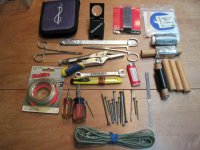
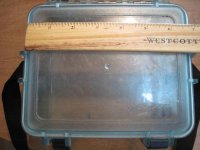
Sewing kit
Collapsible magnifying glass
Sharpening stone
Mattress repair kit
Curved hemostats
Hacksaw blade
Flat hemostats
Duct tape
Roofing mastic tape
Stainless steel wire
Small vice grips
Box and open end wrench to fit seat hardware
Wallpaper razor knife, brass wire.
Lighter
Seat hangers, one with hardware and wrapped with gorilla tape
Phillips and regular screwdriver
Various nails and screws
Small file
3 mm line


Good info on various kits. I have similar stuff in my kits.
RE pitch: I always wondered how the Voyageurs made their repair "pitch", having never read about the precise actual recipes.

Frances Ann Hopkins painting, source: http://www.histoireforestiereoutaouais.ca/en/wp-content/uploads/2013/08/a7-01.jpg
Well YouTube to the rescue. There are many YT videos on making pitch glue. Its a rendered mixture (with heat in a metal container), of pine or spruce pitch (often called "resin"), mixed with powdered charcoal, and rabbit or moose droppings which provide a fine dry fiber for a binding agent. These ingredients are readily available on any canoe route in the north. Watching many videos with various ratios of ingredients, it seems to work quite well. I don't know what the optimum ratios are.
Preparing it will sacrifice a pot. Many folks use a tin can. To carry it for a kit, they wrap the heated mixture around a stick. Keep turning and collecting the glob that forms on the stick, and it dries to a non sticky hardness. The glue is re-activated for application by heating it over a flame, or in a tin can, and the stick is a no mess hand held applicator. I like the idea. I have never made it, but like to think I can, and I carry an old tuna can in my kit which is my tent mosquito coil container, and this could serve as a pitch glue rendering pot. I would hate to make pitch glue in one of my cooking pots
However I have always wondered if this simple mixture is flexible enough to not crack and flake off. I seem to recall reading that the Voyageurs mixed animal fat into the mixture as well, to make it flexible? I need to test this out one of these days. I have a bag of spruce pitch somewhere in my basement, collected for this very task. I will report back whenever I get this heritage skill practiced and done!
RE pitch: I always wondered how the Voyageurs made their repair "pitch", having never read about the precise actual recipes.

Frances Ann Hopkins painting, source: http://www.histoireforestiereoutaouais.ca/en/wp-content/uploads/2013/08/a7-01.jpg
Well YouTube to the rescue. There are many YT videos on making pitch glue. Its a rendered mixture (with heat in a metal container), of pine or spruce pitch (often called "resin"), mixed with powdered charcoal, and rabbit or moose droppings which provide a fine dry fiber for a binding agent. These ingredients are readily available on any canoe route in the north. Watching many videos with various ratios of ingredients, it seems to work quite well. I don't know what the optimum ratios are.
Preparing it will sacrifice a pot. Many folks use a tin can. To carry it for a kit, they wrap the heated mixture around a stick. Keep turning and collecting the glob that forms on the stick, and it dries to a non sticky hardness. The glue is re-activated for application by heating it over a flame, or in a tin can, and the stick is a no mess hand held applicator. I like the idea. I have never made it, but like to think I can, and I carry an old tuna can in my kit which is my tent mosquito coil container, and this could serve as a pitch glue rendering pot. I would hate to make pitch glue in one of my cooking pots
However I have always wondered if this simple mixture is flexible enough to not crack and flake off. I seem to recall reading that the Voyageurs mixed animal fat into the mixture as well, to make it flexible? I need to test this out one of these days. I have a bag of spruce pitch somewhere in my basement, collected for this very task. I will report back whenever I get this heritage skill practiced and done!
- Joined
- Mar 20, 2013
- Messages
- 3,356
- Reaction score
- 972
Talking about pitch, I have a client that brought me a canoe to get repaired. They rapped the canoe, a kevlar Clipper whitewater II and the boat have big cracks in it, so wha they did since they had a really limited repair kit, they gathered some spruce pitch, they warmed it up over the fire in a pot, they might have added some other stuff to it I'm not sure, they gooped the stuff over the cracks, added some tape over it, and waited for the mixture to solidified, they finish there trip and brought the canoe to me... The stuff is supper hard and the hull is stiff where the repair was done!!
- Joined
- Mar 20, 2013
- Messages
- 3,356
- Reaction score
- 972
Good info on various kits. I have similar stuff in my kits.
RE pitch: I always wondered how the Voyageurs made their repair "pitch", having never read about the precise actual recipes.

Frances Ann Hopkins painting, source: http://www.histoireforestiereoutaouais.ca/en/wp-content/uploads/2013/08/a7-01.jpg
Well YouTube to the rescue. There are many YT videos on making pitch glue. Its a rendered mixture (with heat in a metal container), of pine or spruce pitch (often called "resin"), mixed with powdered charcoal, and rabbit or moose droppings which provide a fine dry fiber for a binding agent. These ingredients are readily available on any canoe route in the north. Watching many videos with various ratios of ingredients, it seems to work quite well. I don't know what the optimum ratios are.
Preparing it will sacrifice a pot. Many folks use a tin can. To carry it for a kit, they wrap the heated mixture around a stick. Keep turning and collecting the glob that forms on the stick, and it dries to a non sticky hardness. The glue is re-activated for application by heating it over a flame, or in a tin can, and the stick is a no mess hand held applicator. I like the idea. I have never made it, but like to think I can, and I carry an old tuna can in my kit which is my tent mosquito coil container, and this could serve as a pitch glue rendering pot. I would hate to make pitch glue in one of my cooking pots
However I have always wondered if this simple mixture is flexible enough to not crack and flake off. I seem to recall reading that the Voyageurs mixed animal fat into the mixture as well, to make it flexible? I need to test this out one of these days. I have a bag of spruce pitch somewhere in my basement, collected for this very task. I will report back whenever I get this heritage skill practiced and done!
I've read a bit about the birch bark canoe pitch, and never heard of the moose or rabbit dropping... But what I read in multiple historic books, is as follow, spruce or fir pitch/gum, charcoal or hashes, bear fat( or pure lard) I'm not sure of the quantity, but the fat is to keep it flexible, the hashes as a binding agent... That is what I found in different books and old birch bark documentary films. I'm sure there was a lot of different variations....
Saw video years ago about melting a plastic milk jug and using it to patch an aluminum canoe. I 've not tried it but should !
Also saw where a Styrofoam cup was melted in gasoline, and this was used as a form of glue.
Again I've not tried either of these, so try for yourself before depending on them to save your canoe.
Like the idea of a birch bark patch, with some pine pitch. Might not stick to Royalex.
As Hoop say's we need a test !! Hint !! Hint !
Jim
Also saw where a Styrofoam cup was melted in gasoline, and this was used as a form of glue.
Again I've not tried either of these, so try for yourself before depending on them to save your canoe.
Like the idea of a birch bark patch, with some pine pitch. Might not stick to Royalex.
As Hoop say's we need a test !! Hint !! Hint !
Jim
- Joined
- Mar 20, 2013
- Messages
- 3,356
- Reaction score
- 972
Talking about pitch, I have a client that brought me a canoe to get repaired. They rapped the canoe, a kevlar Clipper whitewater II and the boat have big cracks in it, so wha they did since they had a really limited repair kit, they gathered some spruce pitch, they warmed it up over the fire in a pot, they might have added some other stuff to it I'm not sure, they gooped the stuff over the cracks, added some tape over it, and waited for the mixture to solidified, they finish there trip and brought the canoe to me... The stuff is supper hard and the hull is stiff where the repair was done!!
Like I said up here^^^^, it does work even if not mixed with the exact ingredients!!
We can usually deal with most any mishap in the field using duct tape and supplies on hand.
Here are the guys replacing a broken portage thwart, using a folding saw and much nylon cord. This was a day trip with 6 miles left to get out, no trails.
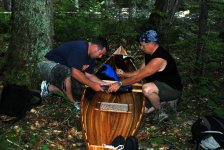
Next is a minor above the waterline puncture, completely my fault for tossing my hull onto a beaver chewed stump along the Harrington Brook carry.
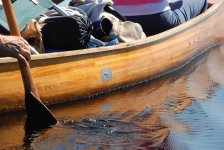
And here's that same boat, 5 years later, with a desperate field repair after being pinned in Round Lake Stream. The boys paddled another 6 miles (and carried another 1.8 miles) with several stops to dump the water from the ever accumulating cracks and splits. An abandoned shovel, some driftwood, lots of nylon cord. Sadly, this was the end for her...
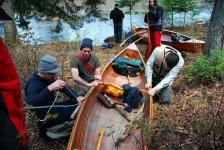
Here are the guys replacing a broken portage thwart, using a folding saw and much nylon cord. This was a day trip with 6 miles left to get out, no trails.

Next is a minor above the waterline puncture, completely my fault for tossing my hull onto a beaver chewed stump along the Harrington Brook carry.

And here's that same boat, 5 years later, with a desperate field repair after being pinned in Round Lake Stream. The boys paddled another 6 miles (and carried another 1.8 miles) with several stops to dump the water from the ever accumulating cracks and splits. An abandoned shovel, some driftwood, lots of nylon cord. Sadly, this was the end for her...

Good info on various kits. I have similar stuff in my kits.
RE pitch: I always wondered how the Voyageurs made their repair "pitch", having never read about the precise actual recipes.

Frances Ann Hopkins painting, source: http://www.histoireforestiereoutaouais.ca/en/wp-content/uploads/2013/08/a7-01.jpg
Well YouTube to the rescue. There are many YT videos on making pitch glue. Its a rendered mixture (with heat in a metal container), of pine or spruce pitch (often called "resin"), mixed with powdered charcoal, and rabbit or moose droppings which provide a fine dry fiber for a binding agent. These ingredients are readily available on any canoe route in the north. Watching many videos with various ratios of ingredients, it seems to work quite well. I don't know what the optimum ratios are.
Preparing it will sacrifice a pot. Many folks use a tin can. To carry it for a kit, they wrap the heated mixture around a stick. Keep turning and collecting the glob that forms on the stick, and it dries to a non sticky hardness. The glue is re-activated for application by heating it over a flame, or in a tin can, and the stick is a no mess hand held applicator. I like the idea. I have never made it, but like to think I can, and I carry an old tuna can in my kit which is my tent mosquito coil container, and this could serve as a pitch glue rendering pot. I would hate to make pitch glue in one of my cooking pots
However I have always wondered if this simple mixture is flexible enough to not crack and flake off. I seem to recall reading that the Voyageurs mixed animal fat into the mixture as well, to make it flexible? I need to test this out one of these days. I have a bag of spruce pitch somewhere in my basement, collected for this very task. I will report back whenever I get this heritage skill practiced and done!
I experimented a bit when making pitch for my birchbark canoe. Some sort of saturated fat (bear grease, lard,or even vegetable shortening) is needed for the flexibility but there is a catch. The pitch has to be custom made for the ambient temperature (i.e. cool spring or fall vs warmer summer weather). It is a very hands on guess work type of thing rather than a set formula of ratios. Once the cleaned resin is melted, you gradually add small amounts of fat and evaluate the mixture. One way is to stir with stick, lift up and monitor the strands of gum that drip off. A perfect mixture gives off a strand that can bend without cracking.
A more visual method that I preferred involved dipping a sample of test bark in the heated pitch, then quickly dipping it into cold water, preferably the water you're planning to paddle. The bark sample is then bent back on itself and the gum evaluated for pliability. If there is insufficient fat, it'll crack and if there's too much fat, it'll be greasy and drip off. Here's a pic when I did a small test run for a bark canoe model :
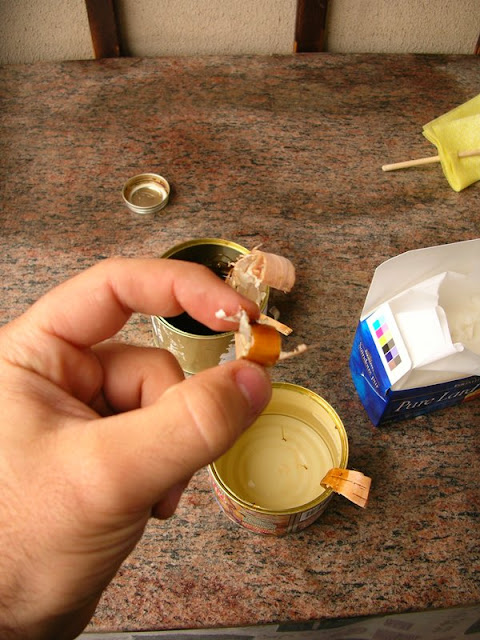
The strip of of bark was dipped in the melted pitch, dunked in cold water and then bent back and forth. After a few attempts, the right mixture formed a permanent and flexible seal in that moment. Didn't use powdered charcoal as an additional binding agent and many bark canoe builders like Ferdy Goode and Steve Cayard don't add powdered charcoal to the mix.
When I pitched my full scale canoe (in early April), I did use powdered char because I read somewhere it meant better adhesion. Everything worked well for the 1st water test on that sunny April day.
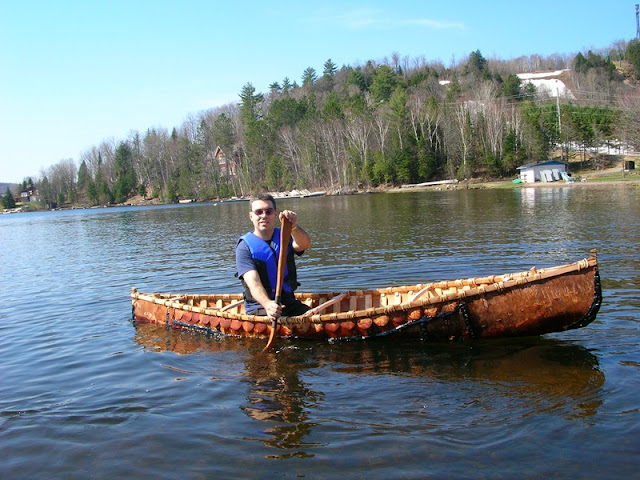
But fast forward to August during a heat wave and the pitch started to run despite the canoe being stored in the relative cool of a shaded garage.
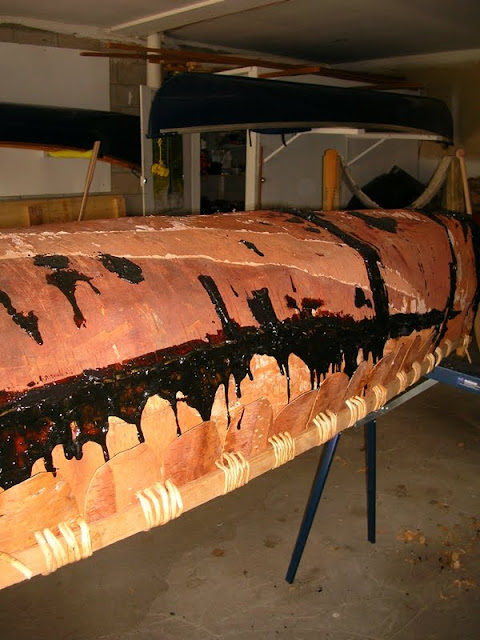
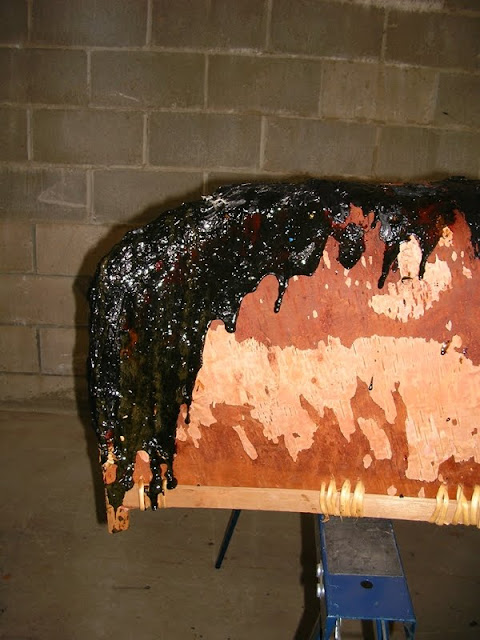
Pretty ugly mess! In the end I had to wait until temperatures dropped again that winter. Let the canoe sit outside a bit and freeze and then chipped away the runs to repitch it again in the following season.
Basically, as a temporary means of repair the tree gum/pitch method could be effective in emergencies but it needs a lot of attention and constant recipe fixing if it's going to be used long term to get you out of extended trip mishap. Guess that's why duct tape is in most everyone's kit...so much more simple. But the pitch thing still be a useful to know if your repair kit gets lost on a trip.
After reading survival of the bark canoe I always wondered why Henri Vaillancourt was so opposed to using pitch. I think he uses roofing tar, but that definitely explains it. Thanks Murat, and that is a really awesome canoe you built.
Similar threads
- Replies
- 8
- Views
- 1K
- Replies
- 13
- Views
- 2K
- Replies
- 8
- Views
- 1K
